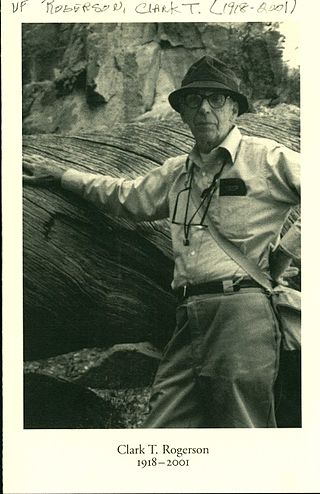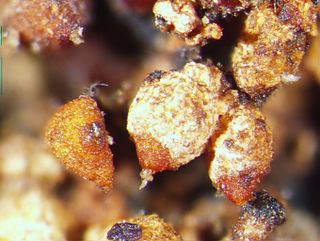
Nectria is a genus of Ascomycete fungi. They are most often encountered as saprophytes on decaying wood but some species can also occur as parasites of trees, especially fruit trees and a number of other hardwood trees. Some species are significant pests causing diseases such as apple canker, Nectria twig blight, and coral spot in orchards.

The Nectriaceae comprise a family of fungi in the order Hypocreales. It was circumscribed by brothers Charles and Louis René Tulasne in 1865. In 2020, an Outline of fungi was produced and listed 70 genera and about 1,336 species.

The Bionectriaceae are a family of fungi in the order Hypocreales. A 2008 estimate places 35 genera and 281 species in the family. Species in the family tend to grow on plant material, including woody debris, while some species associate with algae, bryophytes, or other fungi.
Hydropisphaera is a genus of fungi in the class Sordariomycetes. It consisted of 18 species in 2008, and 32 species in 2023.

Lasionectria is a genus of fungi in the class Sordariomycetes. It consisted of six species in 2008, and 16 in 2023.

Nectriopsis is a genus of fungi in the class Sordariomycetes. The number of species in this genus varies between sources. The Dictionary of Fungi lists only 58 species, but the Catalogue of Life includes 72 species.
Protocreopsis is a genus of fungi in the class Sordariomycetes. It consisted of nine species in 2008, and up to 11 species in 2023.
Conioscyphascus is a fungal genus in the Sordariomycetes class of the Ascomycota. The relationship of this taxon to other taxa within the class is unknown, and it has not yet been placed with certainty into any order or family. The genus, Conioscyphascus contains the single species Conioscyphascus varius, described as new to science in 2004. Until Conioscyphascus gracilis(Munk) Réblová & Seifert was found later in 2004.

Corallomycetella is a genus of ascomycete fungi in the family Nectriaceae. Species of Corallomycetella are tropical, and are characterized by the formation of brightly colored rhizomorphs of their rhizostilbella-like asexual morphs. These fungi causes a number of plant diseases including 'violet root rot' of Theobroma cacao, root rot of Carica papaya, and 'stinking root disease' of several tropical woody plants. Two species of Corallomycetella are recognized: Corallomycetella elegans C. Herrera & P. Chaverri and Corallomycetella repens Rossman & Samuels. Corallomycetella jatrophae is now classified under Corallonectria.

Cosmospora is a genus of ascomycete fungi in the family Nectriaceae. The genus, as circumscribed by Rossman et al. (1998), included all the nectrioid species with small, reddish, non-ornamented sexual fruiting bodies that collapse laterally when dry. However, the genus was shown to be polyphyletic, and the majority of species were re-classified into revived or recently established genera that are monophyletic. Cosmosporasensu Rossman housed members of the following genera: Chaetopsina, Cylindrocladiella, Fusicolla, Macroconia, Mariannaea, Microcera, Pseudocosmospora, Stylonectria, and Volutella. Cosmospora was restricted to species having acremonium-like asexual morphs that grow on polypores and xylariaceous fungi by Gräfenhan in 2011. About 20 species are accepted in the genus.

Clark Thomas Rogerson was an American mycologist. He was known for his work in the Hypocreales (Ascomycota), particularly Hypomyces, a genus of fungi that parasitize other fungi. After receiving his doctorate from Cornell University in 1950, he went on to join the faculty of Kansas State University. In 1958, he became a curator at The New York Botanical Garden, and served as editor for various academic journals published by the Garden. Rogerson was involved with the Mycological Society of America, serving in various positions, including president in 1969. He was managing editor (1958–89) and editor-in-chief (1960–65) of the scientific journal Mycologia.
Campylocarpon pseudofasciculare is a species of parasitic fungus in the family Nectriaceae. Described as new to science in 2004, it is one of several pathogens associated with black foot disease in grape.
Campylocarpon is a genus of ascomycete fungi in the family Nectriaceae. The genus was described in 2004. The two species in the genus, C. fasciculare and C. pseudofasciculare, are associated with black foot disease of grapevines, in which the roots develop black, sunken, necrotic lesions.

Corallonectria is a genus of ascomycete fungi in the family Nectriaceae. Species of Corallonectria are Neotropical. These fungi are characterized by the formation of brightly colored rhizomorphs and of copulated synnematous fusarium-like asexual morphs in culture. The asexual morph in nature has been rarely observed. The sexual fruiting bodies are furfuraceous and usually seated at the base of a reddish synnemata. It is a monotypic genus containing the sole species Corallonectria jatrophae. This species was formerly classified under Corallomycetella.
Clonostachys is a genus of fungi in the order Hypocreales and family Bionectriaceae.

Volutella is a genus of fungi belonging to the family Nectriaceae.

Mariannaea is a genus of fungi belonging to the family Nectriaceae.
Microcera is a genus of Ascomycete fungi in the Nectriaceae family.
Conioscypha is a genus of terrestrial and freshwater fungi in the monotypic family Conioscyphaceae and the monotypic order Conioscyphales. They are found on decayed wood, leaves, or bamboo stems. Except for Conioscypha japonica which was isolated from dog skin fragments and hair in 2017.

Pleurothecium is a genus of terrestrial and freshwater fungi in the family Pleurotheciaceae. It is typified by Pleurothecium recurvatum as the type species (Morgan) Höhn, which has the synonym of Carpoligna pleurotheciiF.A. Fernández & Huhndorf, Mycologia 9: 253. 1999.












